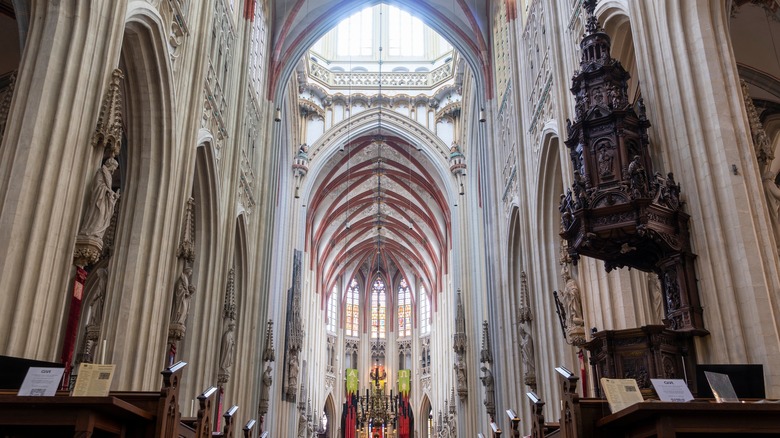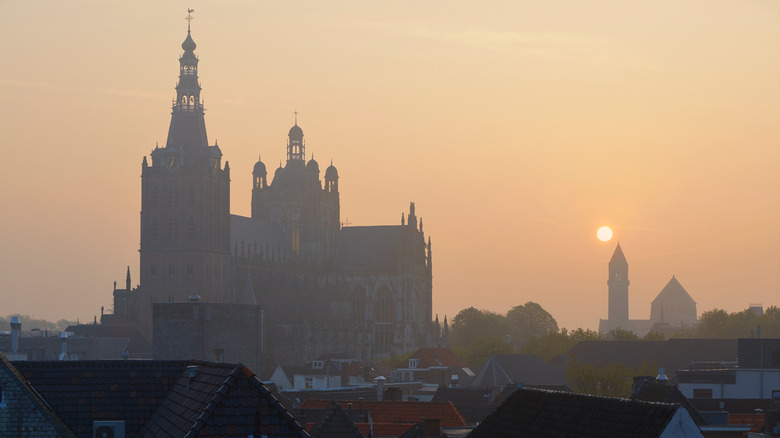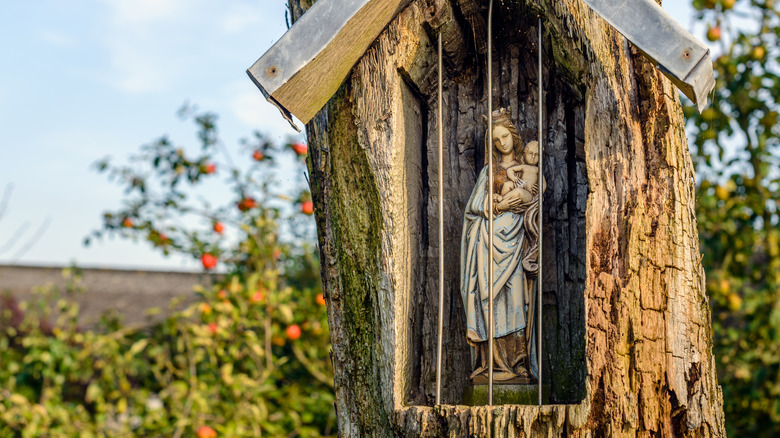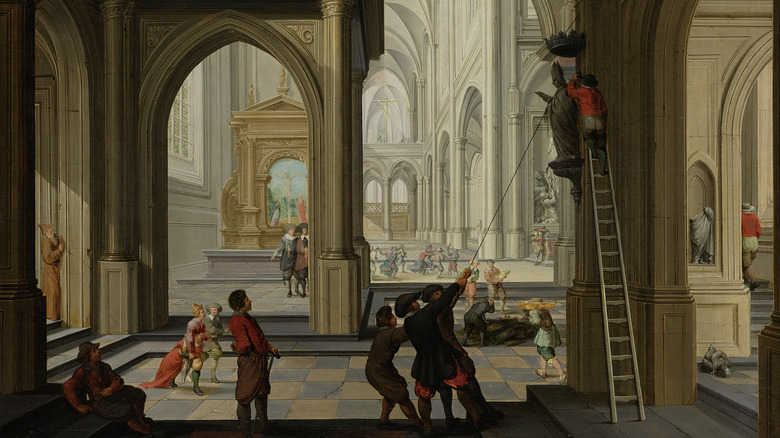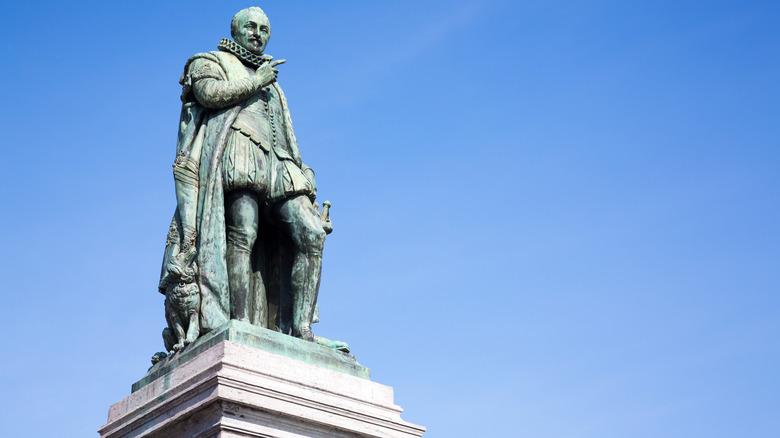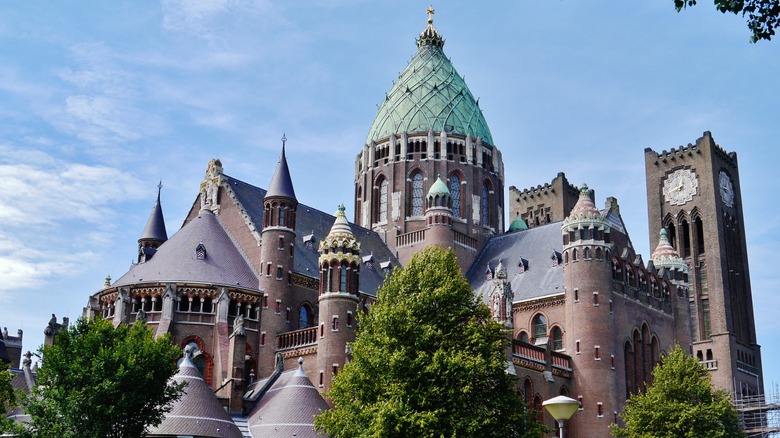Why So Many Catholic Churches In The Netherlands Were Destroyed In The 16th Century
When a new political or cultural regime steps into place, oftentimes it makes its mark by removing or replacing architecture, statues, and religious iconography. The First Temple in Jerusalem lasted all the way from about 1200 B.C.E. until it was destroyed by the Babylonian King Nebuchadnezzar when he invaded in 586 B.C.E., as Moon describes. When Muslim rule took root in India from 1200 C.E. to 1398 C.E., loads of Hindu temples were obliterated, per Vedic Feed. More recently, when Nazi Germany rolled though France they tore down every statue and monument they could in order to reclaim metal, as The Vintage News explains. This is just a meager fraction of the same pattern repeated over and over again across the world for thousands of years of human civilization.
To all this some people might say, "It's just a building or statue, who cares?" Maybe that's true of modernity's cookie-cutter, throwaway approach to everything from condos to t-shirts, plastic cups to children's toys. But it's certainly not the case for history-defining structures used to represent an entire people or nation and their culture, like the Colosseum in Rome, Arc de Triomphe in Paris, or the World Trade Center in New York City, destroyed in 2001. Such things are definitely not "just buildings," especially not if other groups go through such determined lengths to tear them down. Such was the case during the Netherland's Protestant Reformation, one of the most violent religious periods in recent history, when Catholic churches were targeted for destruction.
Waystation for Puritans headed to America
In the present day, the Netherlands — one of Earth's most socially progressive countries, as Medium reports — is littered with not only churches, but converted churches. It's easy to spot colossal and ornate Catholic cathedrals versus newer, more modest Protestant structures. Churches like Grote Kerk (literally "Great Church") in The Hague used to be Catholic, but was converted to Protestant use in 1572 at the onset of the Netherland's 80-year-long Protestant Reformation, described in detail by World History Encyclopedia. There are stains on Grote Kerk's stone walls from where statues once stood. Remnants of iconography can be seen, but only minimally. At present, the church isn't even used for religious purposes — it's an event hall that can be rented for everything from whiskey festivals to pipe organ-driven Bach concerts.
In ways such as these, modern-day Netherlands echoes its past. The Netherlands is not only a very socially progressive country, but a highly pragmatic place with a strong Protestant heritage. Americans jabber about the U.S.' "Protestant work ethic," and how the nation was built on the backs of stern-faced, no-fuss Puritanical Christians. Well, those Puritans first fled the Church of England and headed to the Netherlands, as History explains. There, they found like-minded believers — ones from England's rival maritime superpower — who gave them safe harbor. Then, they shipped off to "The New World" and founded Plymouth in 1620. This, however, happened only as the Netherlands emerged from almost 50 years of religious violence.
Under the thumb of Spain
Even though we're talking about the Netherlands like it was its own, cohesive country, the nation wasn't even independent when its Protestant Reformation began. From 1556 to 1598 the Netherlands was under the rule of Spain, a very Catholic nation, as the World History Encyclopedia says. As The Hague International Centre recounts, the Netherlands and its people were granted to the Spanish King Philip II as a gift in 1555. In many ways, the rise of Protestantism in the Netherlands, and attacks from within the nation against Catholic churches, had far less to do with Christian doctrine and everything to do with rebelling against Spanish rule.
German priest Martin Luther had kicked off the Protestant Reformation only about 40 years prior, in 1517. As World History Encyclopedia explains, he tacked his 95 Theses to the door of Wittenburg Church in Germany to protest Catholic practices like the selling of indulgences to hasten the release of family members from purgatory. From that point on, Christianity rapidly splintered into innumerable, non-Catholic sects: Lutherans, Anabaptists, Zwinglians, Mennonites, Calvinists, and many more. These sects had different interpretations of Christian theology, different influences, and different leaders. In the Netherlands Calvinism wound up winning out, as Dutch Review explains, but only decades after the country's Eighty Years' War against Spain ended with Dutch independence in 1648. Until then, every Protestant group was united in its attacks against Catholicism and Catholic churches.
Decades of iconoclasm against Catholic churches
The painting "Iconoclasm in a Church" by Dirk van Delen (pictured above) provides us with a good glimpse of Dutch Protestant rebellion against Spanish rule. As Amsterdam's Rijksmuseum states, the painting dates to 1630, and depicts a particularly brutal day of violence in 1566 known as the "Beeldenstorm" (statue storm) against altarpieces and "sacred vessels," with nooses used to yank Catholic statues from their plinths. During the entire Dutch Protestant Reformation, which overlapped with the Eighty Years' War from 1568 to 1648, Catholic churches faced multiple rounds of such iconoclasm.
Even before the Reformation, Protestant Melchiorites defaced churches en masse from 1531 to 1535. As a result, over 30,000 of them were jailed or executed from 1537 to 1547, per World History Encyclopedia. When Philip II received the Netherlands as a gift in 1555, he "gave inquisitors and local magistrates a free hand in identifying and destroying those defined as 'heretics.'" And so the cycle of violence continued.
Meanwhile, Calvinism had gained a major foothold in the Netherlands in the 1540s. Calvinists had fled religious persecution in France after posting "anti-pope messages" throughout the country. Like other Protestant sects, Calvinist groups got tangled up in politics until they became indistinguishable from political groups, and in the Netherlands faced persecution for anti-Spanish activities. So did the Mennonites, who bizarrely faced persecution not for committing acts of violence, but because they were pacifists. They refused to participate in "public affairs," and thus were deemed "a threat to the state."
The Williams of Orange
In the end, there were two separate individuals dubbed "William of Orange" who helped end the Dutch Protestant Reformation and its defacement of Catholic churches. The first William of Orange, also called William the Silent, for his closely-held opinions, lived from 1533 to 1584 at the onset of the Eighty Years' War, while the other lived afterwards from 1650 to 1702. Both Williams were "stadholders," or administrators of the general Netherlands region, and both from the region of Orange.
William the Silent was raised Lutheran, but had converted to Catholicism by the time the church's Cardinal Granvelle headed back to Rome. Granvelle had headed up the policies of persecution and retaliation against Dutch Protestants who'd attacked Catholic churches, as World History Encyclopedia reports. Having seen both faces of Christianity, William was "a strong advocate of freedom of religion" and eventually led Dutch Protestant forces against Spain until he was assassinated in 1584.
William the Orange — the second one — was raised Calvinist, and found himself beholden to English powers rather than Spanish, as Historic UK states. He became stadholder during yet another war-ridden time in Dutch history, where the Netherlands faced off against England, France, and Germany in various conflicts. In response, William eventually deposed the English King James II, an ardent Catholic, and installed himself as ruler of England along with James' daughter, Mary II. Known as the Glorious Revolution, this led directly to England banning Catholics from taking the English throne, forever.
A modern, secular nation
At present, such old animosities are long gone from the Netherlands, no matter how their imprints remain in architecture and culture. Folks can stroll through Catholic churches that weren't defaced, those that were, or those that were converted to Protestant use, like those listed on Klarna. Orange is the country's official color, after William of Orange who fought against Spanish rule during the Eighty Years' War, per Netherlands Insider. And as Dutch Review says, 82% of Dutch people "neither attend church or believe in God." And yet, the Netherlands is considered very culturally Protestant, in a general sense.
In a very real way, the Netherlands' non-religious nature is a holdover from its old Reformation-rooted desire for religious freedom. The country has retained cultural, attitudinal elements of Calvinism, but done away with its reliance on religion to wield those elements, as well as center its moral and national identity. For instance, the Netherlands decriminalized marijuana in 1992, dispenses sex education and contraception from age 12, and legalized gay marriage in 2001 (per Medium and the Government of the Netherlands, respectively). And yet, without such a tooth-clenching grip on religion to devise political policies, drug use in the Netherlands is half that of the U.S., children have sex later than in more conservative societies, and divorce rates are half that of the U.S. (the latter per CBS and Wilkinson and Finkbeiner). Such figures, and the Netherlands itself, provide a good model for nations still grappling with similar issues.
